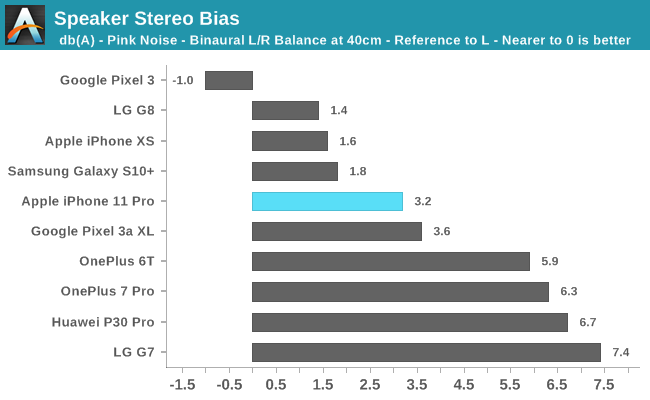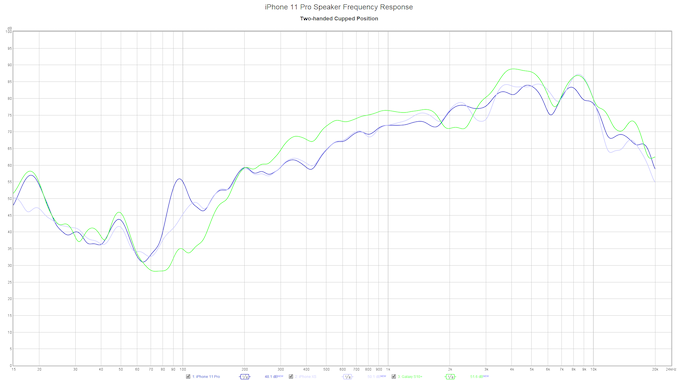The Apple iPhone 11, 11 Pro & 11 Pro Max Review: Performance, Battery, & Camera Elevated
by Andrei Frumusanu on October 16, 2019 8:30 AM ESTVideo Recording
Video recording on the iPhone is known to be extraordinarily good in terms of quality. The iPhone 11 series is said to improve in this regard thanks to an improved HDR with more dynamic range (though Apple still stores video in SDR format). Naturally of course what’s also exciting is that we’re now able to capture video with a wide-angle lens, and seeing a lot more content of a given scene.
Apple has improved the EIS this generation, and it now results in a much smoother video capture experience than the past iterations. When you have with a lot of detail in a scene though, you can sometimes see the jitter caused by the OIS and EIS interacting with each other.
In the wide-angle recording, the EIS was a bit haphazard. In the first part of the video walking down the path it doesn’t look to be stabilizing much at all, when I turn left to the second path suddenly the EIS kicked in and things were a lot less shaky, and it then again loses the stabilization for few steps until it finally resumes again. This happened all three recordings with the wide-angle camera, and I don’t know it was me holding the phone any different between those two paths.
The quality and detail of the videos are all great. The one thing noticed though is that there’s the occasional exposure flicker in some areas. In effect Apple here is doing two exposures per frame and combining them together like Smart HDR – we can notice that in parts of the scene, and most visible the sky is flickering or pulsing in brightness.
The handling between the three camera sensors is very good, it’s particularly fast and seamless to switch between the main and wide-angle modules, while there’s a small delay to switch to the telephoto module. Switching between the three modules is only possible in 30fps recording modes; it’s still possible to record 60fps in any of the three modules but you have to start out the video with the camera that you want to use, and you’ll be limited to digital zooming only while recording.
Speaker Evaluation
In terms of audio for the iPhone 11 series, Apple’s big addition is the inclusion of Dolby Atmos. Naturally you have to watch multi-channel audio content to be able to take advantage of the feature. For regular stereo audio playback, we investigate if Apple has done any changes to the speaker setup and if it differs to that of the XS.

In terms of audio volume, the iPhone 11 Pro is ever so slightly quieter when being held in portrait mode. The bigger difference that’s definitely more audible is when holding the phone in landscape mode with both hands and the palms cupped – the usual way one would hold a phone in landscape. Here it’s 3dB quieter than the iPhone XS, which is a noticeable amount.

Investigating the phone’s stereo bias thanks to a binaural microphone setup, we see that that things have notably regressed for the iPhone 11 Pro when compared to the XS. It’s relatively normal for the main speaker (Right side) to appear louder, however it’s extremely weird that it’s now 1.6dB more biased than on the iPhone XS. Indeed when comparing the 11 Pro and XS side-by-side, and muting the main speaker by holding a finger on it, volume being equal and otherwise calibrated between the two phones, it’s immediately audible that the 11 Pro earpiece speaker is much quieter compared to what we experience on the XS.
This has a rather large knock-on effect on the spatial sound reproduction of the 11 Pro as it just isn’t able to fill up the surrounding area quite as well as on the XS.
Looking at the frequency response between the 11 Pro and the XS, we see that things are extremely similar up to the high mid-ranges, with a more noticeable peak at 95Hz for the 11 Pro. Towards the treble we see some more deviations, it’s here that the 11 Pro is a bit quieter and I think that’s due to the weaker earpiece speaker.
Overall, the sound signature of the iPhone 11 Pro hasn’t changed all too much, and it is actually more of a downgrade in audio playback due to the weaker earpiece speaker calibration. The Galaxy S10’s notably stronger lower mid-range and mid-range still make for a much superior audio playback and is in my experience the device to beat in terms of speaker quality.











242 Comments
View All Comments
Narg - Thursday, October 17, 2019 - link
Very poor review. Seems this reviewer has a complex, and one that doesn't bode well for an average consumer.WuMing2 - Thursday, October 17, 2019 - link
Could anybody point out a -professional- use case for a $1k smartphone? Because I call, text, surf, recognize, edit, share and snap perfectly useless pictures with iOS 13...on iPhone 6s.I believe few years back the peak of refinement for common functions has been reached for 99% of users. And all smartphone vendors are burning insane amounts of resources to solve non-existing problems. While some very obvious ones - as system-wide annotations of info and objects to personalize and learn as we commonly do in the real world - are still missing. To their credit Apple employees achieve that with the most tasteful and responsible of products.
hlovatt - Thursday, October 17, 2019 - link
Great review. Really enjoyed the in-depth analysis of the CPU.It is interesting that the wide angle camera is treated so differently than the other two in low light.
On the subject of the Camera, does any one know the:
1. Bust frame rate?
2. The live photo frame rate?
primet - Friday, October 18, 2019 - link
not sure why anandtech insist of calling the ultra wide as wide angle.The_Assimilator - Friday, October 18, 2019 - link
While I may loathe Apple as a company for its rubbish products, overhyped designs, predatory repair practices, eocsystem lock-in, and ridiculous price-gouging...I cannot help but give kudos to Apple's CPU design team. Sure, Arm is not x86 in terms of complexity, but the fact that Apple has a chip that is both far faster and far more power-efficient than their Android competition, that is using the same underlying architecture, is incredibly impressive. Equally impressive is that they have managed to maintain this dominance over multiple generations, and that the competition still seems as far away from catching up as ever.
joms_us - Friday, October 18, 2019 - link
If you haven't seen speed tests for the last 2-3 years, iPhone is lagging vs competition. Even the iPhone 11 is slower than iPhone XS.Oyeve - Friday, October 18, 2019 - link
Yet in the real world some other phones open and/or maintain speed faster than IP11.varase - Friday, October 18, 2019 - link
Chart: The iPhone 11's IP68 is only good for 2 meters for 30 minutes.darwiniandude - Friday, October 18, 2019 - link
Thanks for the awesomely detailed review and comparison. Well done, I appreciate the effort!mef - Friday, October 18, 2019 - link
Needless to say, outstanding analysis as usual!Kudos for the ton of painstaking work done to gather and compare all the numbers, images, etc. It's not very precise for a reviewer nor interesting for a savvy reader to just say that one device "feels fast enough”. Instead, taking the analysis to such a highly scientific level is really why I look forward to reading Anandtech’s insightful reviews ;-).